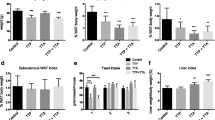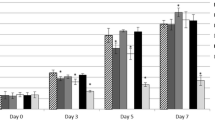Abstract
Vaccenic acid (trans-11-C18:1) chemically resembles elaidic acid (trans-9-C18:1) which is assumed to increase the risk of cardiovascular diseases, and thus could exert similar effects. Possible different oxidation rates of vaccenic versus elaidic acid were checked in muscles and liver, and through related gene expression in normal rat liver cells. In hepatic mitochondria, carnitine palmitoyltransferase (CPT) I exhibited comparable activity rates with both trans-isomers. CPT II activity was 30% greater (P < 0.05) with vaccenic than with elaidic acid as nonesterified fatty acids (NEFAs) or acyl-CoAs. Activity of the first β-oxidation step was similar between the isomers in all the tissue slices and liver extracts assayed. Respiration rates were comparable with both trans-isomers as NEFAs in various liver extracts, but were 30% greater (P < 0.05) with vaccenoyl-CoA than with elaidoyl-CoA in liver mitochondria. Vaccenic acid was oxidised 25% more (P < 0.05) by liver peroxisomes than elaidic acid. In hepatocytes cultured with trans- and corresponding cis-C18:1 isomers, gene expression of CPT I, hydroxyacyl-CoA dehydrogenase and hydroxymethylglutaryl-CoA synthase was at least 100% increased (P < 0.05), but was unchanged with vaccenic acid, relative to controls. In conclusion, the position and geometry of the double bonds in acyl chains are suggested to confer on vaccenic and elaidic acid specific biochemical properties that might differently affect their fates in tissues.





Similar content being viewed by others

Abbreviations
- ACO:
-
Acyl-CoA oxidase
- ACS:
-
Acyl-CoA synthetase
- BSA:
-
Bovine serum albumin
- CPT:
-
Carnitine palmitoyltransferase
- FA:
-
Fatty acid
- HAD:
-
Hydroxyacyl-CoA dehydrogenase
- HMG:
-
Hydroxymethylglutaryl (in HMG-CoA synthase)
- NEFA:
-
Nonesterified FA
- PFAOS:
-
Peroxisomal FA-oxidising system
- PPAR:
-
Peroxisome proliferator-activated receptor
References
Noma A, Yokosuka T, Kitamura K (1983) Plasma lipids and apolipoproteins as discriminators for presence and severity of angiographically defined coronary artery disease. Atherosclerosis 49:1–7
Whayne TF, Alaupovic P, Curry MD, Lee ET, Anderson PS, Schechter E (1981) Plasma apolipoprotein B and VLDL-, LDL-, and HDL-cholesterol as risk factors in the development of coronary artery disease in male patients examined by angiography. Atherosclerosis 39:411–424
Constant J (2004) The role of eggs, margarines and fish oils in the nutritional management of coronary artery disease and strokes. Keio J Med 53:131–136
Han SN, Leka LS, Lichtenstein AH, Ausman LM, Schaefer EJ, Meydani SN (2002) Effect of hydrogenated and saturated, relative to polyunsaturated, fat on immune and inflammatory responses of adults with moderate hypercholesterolemia. J Lipid Res 43:445–452
Schwandt P (1995) Trans-fatty acids and atherosclerosis. Med Monatsschr Pharm 18:78–79
Ackman RG, Mag TK (1998) Trans fatty acids and the potential for less in technical products. In: Sébédio JL, Christie WW (eds) Trans fatty acids in human nutrition, The Oily Press, Dundee
Chardigny JM, Destaillats F, Malpuech-Brugere C, Moulin J, Bauman DE, Lock AL, Barbano DM, Mensink RP, Bezelgues JB, Chaumont P, Combe N, Cristiani I, Joffre F, German JB, Dionisi F, Boirie Y, Sebedio JL (2008) Do trans fatty acids from industrially produced sources and from natural sources have the same effect on cardiovascular disease risk factors in healthy subjects? Results of the trans fatty acids collaboration (transfact) study. Am J Clin Nutr 87:558–566
Wolff RL, Combe NA, Destaillats F, Boue C, Precht D, Molkentin J, Entressangles B (2000) Follow-up of the Delta4 to Delta16 trans-18:1 isomer profile and content in French processed foods containing partially hydrogenated vegetable oils during the period 1995–1999. Analytical and nutritional implications. Lipids 35:815–825
Katan MB, Zock PL, Mensink RP (1995) Trans fatty acids and their effects on lipoproteins in humans. Ann Rev Nutr 15:473–493
Mensink RP, Katan MB (1993) Trans monounsaturated fatty acids in nutrition and their impact on serum lipoprotein levels in man. Prog Lipid Res 32:111–122
Zock PL, Katan MB (1992) Hydrogenation alternatives: effects of trans fatty acids and stearic acid versus linoleic acid on serum lipids and lipoproteins in humans. J Lipid Res 33:399–410
Griinari JM, Bauman DEP (1999) Biosynthesis of conjugated linoleic acid and its incorporation into meat and milk in ruminants. In: Yurawecz MP, Mossoba MM, Kramer JKG, Pariza MW, Nelson GJ (eds) Advances in conjugated linoleic acid research. AOCS Press, Champaign, Urbana
Ledoux M, Rouzeau A, Bas P, Sauvant D (2002) Occurrence of trans-C18:1 fatty acid isomers in goat milk: effect of two dietary regimens. J Dairy Sci 85:190–197
Precht D, Molkentin J (1997) Effect of feeding on trans positional isomers of octadecenoic acid in milk fats. Milchwissenschaft 52:564–568
Ascherio A, Hennekens CH, Buring JE, Master C, Stampfer MJ, Willett WC (1994) Trans-fatty acids intake and risk of myocardial infarction. Circulation 89:94–101
Bolton-Smith C, Woodward M, Fenton S, Brown CA (1996) Does dietary trans fatty acid intake relate to the prevalence of coronary heart disease in Scotland? Eur Heart J 17:837–845
Willett WC, Stampfer MJ, Manson JE, Colditz GA, Speizer FE, Rosner BA, Sampson LA, Hennekens CH (1993) Intake of trans fatty acids and risk of coronary heart disease among women. Lancet 341:581–585
Meijer GW, van Tol A, van Berkel TJ, Weststrate JA (2001) Effect of dietary elaidic versus vaccenic acid on blood and liver lipids in the hamster. Atherosclerosis 157:31–40
Tyburczy C, Major C, Lock AL, Destaillats F, Lawrence P, Brenna JT, Salter AM, Bauman DE (2009) Individual trans octadecenoic acids and partially hydrogenated vegetable oil differentially affect hepatic lipid and lipoprotein metabolism in golden Syrian hamsters. J Nutr 139:257–263
Kelley DS, Erickson KL (2003) Modulation of body composition and immune cell functions by conjugated linoleic acid in humans and animal models: benefits vs. risks. Lipids 38:377–386
Pariza MW, Park Y, Cook ME (2001) The biologically active isomers of conjugated linoleic acid. Prog Lipid Res 40:283–298
Høy CE, Hølmer G (1979) Incorporation of cis- and trans-octadecenoic acids into the membranes of rat liver mitochondria. Lipids 14:727–733
Zevenbergen JL, Houtsmuller UM, Gottenbos JJ (1988) Linoleic acid requirement of rats fed trans fatty acids. Lipids 23:178–186
Channing MA, Simpson N (1993) Radiosynthesis of [1–11C] polyhomoallylic fatty acids. J Label Compd Radiopharm 33:541–546
Goldman P, Vagelos PR (1961) The specificity of triglyceride synthesis from diglycerides in chicken adipose tissue. J Biol Chem 236:2620–2623
Korsrud GO, Conacher HB, Jarvis GA, Beare-Rogers JL (1977) Studies on long chain cis- and trans-acyl-CoA esters and acyl-CoA dehydrogenase from rat heart mitochondria. Lipids 12:177–181
Lawson LD, Kummerow FA (1979) Beta-oxidation of the coenzyme A esters of elaidic, oleic, and stearic acids and their full-cycle intermediates by rat heart mitochondria. Biochim Biophys Acta 573:245–254
Lawson LD, Kummerow FA (1979) Beta-oxidation of the coenzyme A esters of vaccenic, elaidic, and petroselaidic acids by rat heart mitochondria. Lipids 14:501–503
Seglen PO (1973) Preparation of rat liver cells. 3. Enzymatic requirements for tissue dispersion. Exp Cell Res 82:391–398
Demizieux L, Degrace P, Gresti J, Loreau O, Noel JP, Chardigny JM, Sebedio JL, Clouet P (2002) Conjugated linoleic acid isomers in mitochondria: evidence for an alteration of fatty acid oxidation. J Lipid Res 43:2112–2122
Veerkamp JH, van Moerkerk TB, Glatz JF, Zuurveld JG, Jacobs AE, Wagenmakers AJ (1986) 14CO2 production is no adequate measure of [14C]fatty acid oxidation. Biochem Med Metab Biol 35:248–259
Smith PK, Krohn RI, Hermanson GT, Mallia AK, Gartner FH, Provenzano MD, Fujimoto EK, Goeke NM, Olson BJ, Klenk DC (1985) Measurement of protein using bicinchoninic acid. Anal Biochem 150:76–85
Niot I, Pacot F, Bouchard P, Gresti J, Bernard A, Bézard J, Clouet P (1994) Involvement of microsomal vesicles in part of the sensitivity of carnitine palmitoyltransferase I to malonyl-CoA inhibition in mitochondrial fractions of rat liver. Biochem J 304:577–584
Degrace P, Demizieux L, Gresti J, Chardigny JM, Sebedio JL, Clouet P (2004) Hepatic steatosis is not due to impaired fatty acid oxidation capacities in C57bl/6j mice fed the conjugated trans-10, cis-12-isomer of linoleic acid. J Nutr 134:861–867
Bronfman M, Inestrosa NC, Leighton F (1979) Fatty acid oxidation by human liver peroxisomes. Biochem Biophys Res Commun 88:1030–1036
Chomczynski P, Sacchi N (1987) Single-step method of RNA isolation by acid guanidinium thiocyanate-phenol-chloroform extraction. Anal Biochem 162:156–159
Degrace P, Moindrot B, Mohamed I, Gresti J, Du ZY, Chardigny JM, Sebedio JL, Clouet P (2006) Upregulation of liver VLDL receptor and FAT/CD36 expression in LDLR−/− ApoB100/100 mice fed trans-10, cis-12 conjugated linoleic acid. J Lipid Res 47:2647–2655
Lippel K, Carpenter D, Gunstone FD, Ismail IA (1973) Activation of long chain fatty acids by subcellular fractions of rat liver. 3. Effect of ethylenic bond position on acyl-CoA formation of cis-octadecenoates. Lipids 8:124–128
Lippel K, Gunstone FD, Barve JA (1973) Activation of long chain fatty acids by subcellular fractions of rat liver. II. Effect of ethylenic bond position on acyl-CoA formation of trans-octadecenoates. Lipids 8:119–123
Faergeman NJ, Knudsen J (1997) Role of long-chain fatty acyl-CoA esters in the regulation of metabolism and in cell signalling. Biochem J 323:1–12
Richieri GV, Ogata RT, Kleinfeld AM (1999) Fatty acid interactions with native and mutant fatty acid binding proteins. Mol Cell Biochem 192:77–85
Guzman M, Klein W, del Pulgar TG, Geelen MJ (1999) Metabolism of trans fatty acids by hepatocytes. Lipids 34:381–386
Coots RH (1964) A comparison of the metabolism of elaidic, oleic, palmitic, and stearic acids in the rat. J Lipid Res 5:468–472
Ono K, Fredrickson DS (1964) The metabolism of 14C-labeled cis and trans isomers of octadecenoic and octadecadienoic acids. J Biol Chem 239:2482–2488
Yu W, Liang X, Ensenauer RE, Vockley J, Sweetman L, Schulz H (2004) Leaky beta-oxidation of a trans-fatty Acid: incomplete beta-oxidation of elaidic acid is due to the accumulation of 5-trans-tetradecanoyl-CoA and its hydrolysis and conversion to 5-trans-tetradecanoylcarnitine in the matrix of rat mitochondria. J Biol Chem 279:52160–52167
Tardy AL, Giraudet C, Rousset P, Rigaudiere JP, Laillet B, Chalancon S, Salles J, Loreau O, Chardigny JM, Morio B (2008) Effects of trans MUFA from dairy and industrial sources on muscle mitochondrial function and insulin sensitivity. J Lipid Res 49:1445–1455
Berge RK, Aarsland A (1985) Correlation between the cellular level of long-chain acyl-CoA, peroxisomal beta-oxidation, and palmitoyl-CoA hydrolase activity in rat liver. are the two enzyme systems regulated by a substrate-induced mechanism? Biochim Biophys Acta 837:141–151
Nakamura MT, Cheon Y, Li Y, Nara TY (2004) Mechanisms of regulation of gene expression by fatty acids. Lipids 39:1077–1083
Louet JF, Chatelain F, Decaux JF, Park EA, Kohl C, Pineau T, Girard J, Pegorier JP (2001) Long-chain fatty acids regulate liver carnitine palmitoyltransferase I gene (L-CPT I) expression through a peroxisome-proliferator-activated receptor alpha (PPARalpha)-independent pathway. Biochem J 354:189–197
McGarry JD, Brown NF (1997) The mitochondrial carnitine palmitoyltransferase system. From concept to molecular analysis. Eur J Biochem 244:1–14
Acknowledgments
We thank Mr Jean-Michel Chardigny DR INRA, Mr Koenraad Duhem, Mrs Corinne Marmonier for helpful discussions, and Mrs Monique Baudoin for figure construction and typing of the manuscript. This work was supported by grants from the CNIEL (Paris) and the Region Bourgogne (Dijon), France.
Author information
Authors and Affiliations
Corresponding author
About this article
Cite this article
Du, ZY., Degrace, P., Gresti, J. et al. Dissimilar Properties of Vaccenic Versus Elaidic Acid in β-Oxidation Activities and Gene Regulation in Rat Liver Cells. Lipids 45, 581–591 (2010). https://doi.org/10.1007/s11745-010-3428-x
Received:
Accepted:
Published:
Issue Date:
DOI: https://doi.org/10.1007/s11745-010-3428-x



